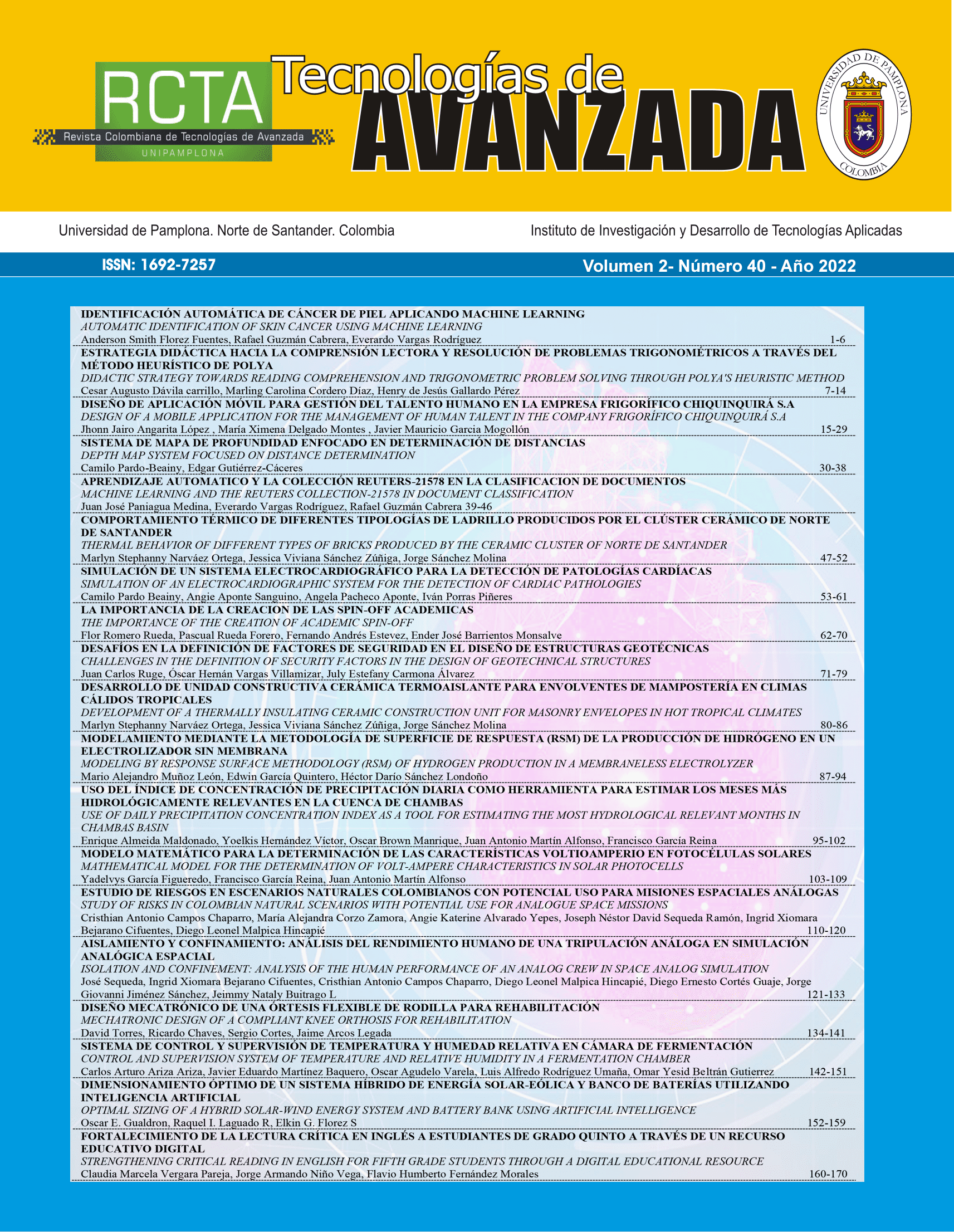Desarrollo de unidad constructiva cerámica termoaislante para envolventes de mampostería en climas cálidos tropicales
DOI:
https://doi.org/10.24054/rcta.v2i40.2355Palabras clave:
Cerámica, Diseño, Aislamiento térmicoResumen
La presente investigación desarrolla un nuevo producto cerámico constructivo con principios termoaislantes, integrando características en la forma interna y externa de la pieza que buscan mitigar la transmitancia térmica del sistema de envolvente de forma pasiva, el diseño asume un modelo que utiliza la dimensión de espesor para generar resistencia térmica en el prototipo, así mismo, crea tabiques internos con geometrías disipadoras que evitan puentes térmicos directos y genera una función de cámaras ventiladas en la primera capa de la pieza para contener y disipar la energía. Para estudiar su eficiencia térmica se implementa método dinámico en simulaciones de distribución de temperatura y flujo de calor bajo condiciones de clima cálido tropical determinando perfiles de temperatura entre la superficie inicial y final de la muestra. Este proceso proyectual permite generar un modelo para fachada cerámica termo-eficiente que reduce 7°C en promedio la energía transferida a través de la mampostería arquitectónica.
Descargas
Referencias
Colmenares A., S. J. (2019). Comparative thermal analysis of extruded ceramic products between multi perforated brick and modified bricks in cells distribution. Journal of Physics: Conference Series, 1386, 28-31.
Colmenares, A. S. (2020). Caracterización térmica y técnica del ladrillo multiperforado a nivel de laboratorio. Respuestas, 25, 43-49.
Halawa E., G. A. (2018). A review on energy conscious designs of building façades in hot and humid climates: Lessons for (and from) Kuala Lumpur and Darwin. Renewable and sustainable energy reviews, 57, 1743-1752.
Hiyama, K. &. (2015). Preliminary design method for naturally ventilated buildings using target air change rate and natural ventilation potential maps in the United States. Energy, 89, 655-666.
IDEAM. (2020). Informe estacion meteorológica Aeropuesto Camilo Daza. Bogotá: Instituto de Hidrología Meteorología y Estudios Ambientales.
Mirrahimi, S. M. (2016). The effect of building envelope on the thermal comfort and energy saving for high-rise buildings in hot–humid climate. Renewable and Sustainable Energy Reviews, 53, 1508-1519.
Narváez M., S. J. (2019). Physical-thermal isolation strategies for the design of sustainable ceramic building units. Journal of Physics: Conference Series, 1645, 1-9.
Narváez M., S. J. (2021). Análisis térmico por método de elementos finitos en nuevos modelos de piezas cerámicas constructivas. Mundo Fesc, 11, 1-8.
Narváez M., S. J. (2021). Analysis of heat fluxes in ceramic block type building pieces. Journal of Physics: Conference Series, 2118, 1-8.
Narváez, M. S. (2019). Comparative evaluation of the physical, mechanical, and thermal properties of traditional H10 and H15 red clay blocks manufactured by the ceramic industry from San José de Cúcuta, Colombia. Journal of Physics: Conference series, 1388, 1-8.
Narváez, M. S. (2020). Cámaras de aire ventiladas en un producto cerámico tradicional para envolventes de mampostería con enfriamiento pasivo. Mundo Fesc, 10, 128-135.
Narváez, M. S. (2020). Experimentación comparativa de transferencia de calor por puente térmico a partir de la modificación de la geometría de los tabiques en bloque cerámico H10. Respuestas, 25, 29-35.
Pacheco R., O. J. (2012). Energy efficient design of building: A review. Renewable and sustainable energy reviews, 16, 3559-3573.
Samani P., L. V. (2016). Comparison of passive cooling techniques in improving thermal comfort of occupants of a pre-fabricated building. Energy and Buildings, 120, 30-44.
Sánchez J., Á. D. (2018). Cisco de Café como posible material sustituto de arcilla en la fabricación de materiales cerámicos de construcción en el área metropolitana de Cúcuta. Respuestas, 23, 27-31.
Sánchez J., R. D. (2013). El clúster de la cerámica del área metropolitana de Cúcuta (Cúcuta: Universidad Francisco de Paula Santander). Cúcuta: Universidad Francisco de Paula Santander.
Sánchez J., S. J. (2020). Desarrollo de un producto cerámico de construcción bajo los principios de la arquitectura bioclimática y sostenible. Ciencia e ingeniería Neogranadina, 30, 29-140.
Santamouris, M. (2016). Cooling the buildings – past, present and future. Energy and Buildings, 128, 617-638.
Sarabia A., S. J. (2017). Uso de nutrientes tecnológicos como materia prima en la fabricación de materiales de construcción en el paradigma de la economía circular. Respuestas, 22, 6-16.
Yao, R. C. (2018). The effect of passive measures on thermal comfort and energy conservation. A case study of the hot summer and cold winter climate in the Yangtze River region. Journal of Building Engineering, 15, 298-310.
Descargas
Publicado
Número
Sección
Licencia
Derechos de autor 2022 Marlyn Stephanny Narváez Ortega, Jessica Viviana Sánchez Zúñiga, Jorge Sánchez Molina

Esta obra está bajo una licencia internacional Creative Commons Atribución-NoComercial 4.0.











